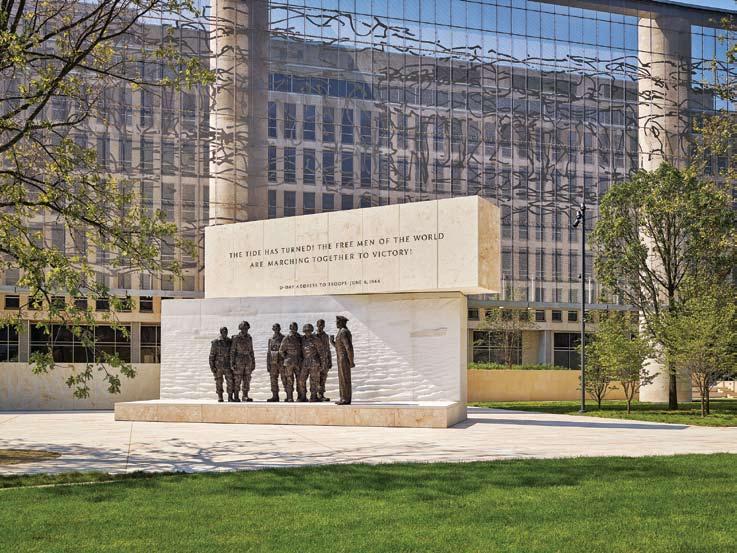
4 minute read
Memorial Days: A look at the soon
Memorial Days
Frank Gehry designed a new Eisenhower Memorial near the National Mall.
Advertisement
By Jennifer Anne Mitchell
Contributing Writer
T h e D w i g h t D . E i s e n h o w e r
Memorial—the eighth presidential memorial in Washington, D.C.—will officially open to the public on Sept. 17, nestled in what used to be a parking lot across the street from the Smithsonian’s National Air and Space Museum. It was designed by renowned architect Frank Gehry as his first public monument. Gehry served in the United States Army’s 3rd Infantry Division during World War II; Eisenhower was the general of that unit. Gehry said in a video interview on the Eisenhower Memorial website that the sense of brotherhood he felt with the president swayed him to take on the project.
The 4-acre site consists of green space, sitting areas, three sculptural scenes, thematic images, and excerpts from Eisenhower’s speeches carved into stone. A 450-foot long and 60-foot high metal tapestry hanging on a cable net system separates the memorial from the U.S. Department of Education building immediately behind it. The woven artwork is a nod to Eisenhower leading troops to victory in World War II: It displays a serene, hand-drawn image of the Normandy beaches at peacetime. The tapestry is lit from the bottom so it is luminescent at night.
One group of sculptures reimagines a famous photo of a pivotal moment in Eisenhower’s role
Photos courtesy of the Eisenhower Memorial Commission
as Supreme Allied Commander, when he spoke with soldiers on the eve of D-Day, before sending them into a battle in which many of them would die.
“The moment is so tense, I didn’t want anything to be light here,” noted the memorial’s sculptor Sergey Eylanbekov in the memorial’s video interview about the project. He says he created symbolism in the artwork by intentionally exaggerating elements, like hands, “to give a sense of weight.”
Another sculpture installation portrays Eisenhower at work as the 34th president, an
Memorial Aerial

office he held for two terms, from 1953 to 1961.
“If you drive on the interstate highway system, if you use your mobile phone today or you watch satellite TV, you can thank Eisenhower,” explains Victoria Tigwell, the deputy executive director of the Eisenhower Memorial Commission. “Because he started all of those things.”
Though his record is not perfect—some argue he could have done more for civil rights and made better assessments during World War II— Eisenhower is widely considered to be one of our greatest presidents. Gallup lists him 12 times as “Most Admired Man.” The memorial website notes pivotal moments in Eisenhower’s life, like serving as the Supreme Commander of NATO to provide security during the Cold War, sending the first U.S. satellite into space, and intervening to stop school segregation in Little Rock, Arkansas. It also includes artifacts from history, like a digitized portion of his farewell address, with handwritten notes, in which Eisenhower warned against the influence of the military–industrial complex.
A third sculpture depicts Eisenhower in his youth, gazing to the center of the memorial, which shows scenes of what would happen later in his life. He came from a family of modest means. The Eisenhower Presidential Library and Museum in Abilene, Kansas, where he grew up, catalogs information about his life on a campus that includes his childhood home. According to the Eisenhower Memorial’s digital interactive timeline of events, the young man who would become president worked at a creamery after graduating high school to put his brother through General Eisenhower Grouping
college. Eisenhower later attended the United States Military Academy, and his childhood nickname “Ike” stuck with him through adulthood.
The Eisenhower Memorial’s tapestry artist Tomas Osinski, who frequently collaborates with Gehry, says he relates to Eisenhower’s humble beginnings. “I came to the United States from Poland in 1981, and I escaped from communists,” he says. “Only in this country is something like that possible. That someone who arrives with a suitcase and nothing else can be a part of such a great [thing].”
Osinski designed and built innovative metal welding machines to create the tapestry, and he says it took 18 months, with multiple machines working almost all day and two shifts of crews operating them, to produce 600 panels of material.
The entire memorial is made of more than 50 pieces of stone, stainless steel, and bronze, and is built to last for 100 years.
Eylanbekov sculpts in Pietrasanta, Italy, and uses a traditional, handmade method that he says is thousands of years old. “Michelangelo lived in this town,” he said in his video interview. “[The statue] ‘David’ is carved from this marble.”
This stalwart site is a stark contrast to the turbulent times in which it was completed. The Eisenhower Memorial’s unveiling comes during a summer in which numerous monuments around the world were defaced or removed following the killing of George Floyd. It comes in the midst of a global pandemic, with more than










